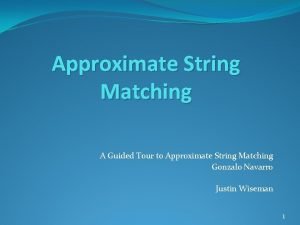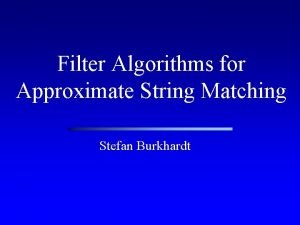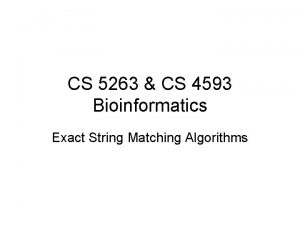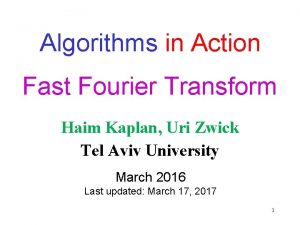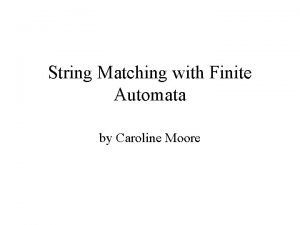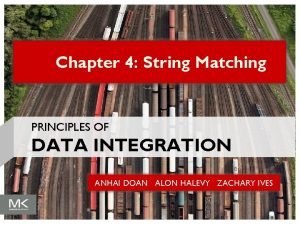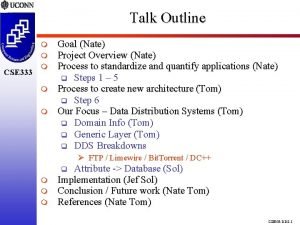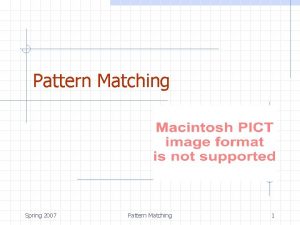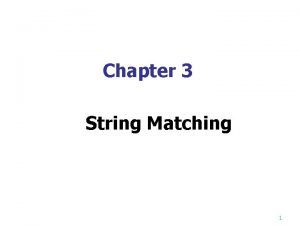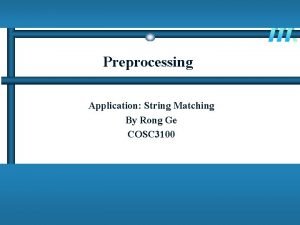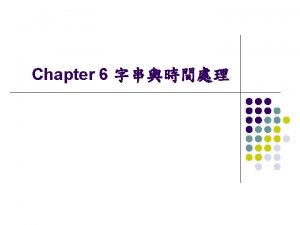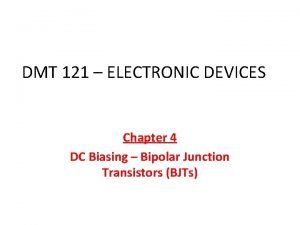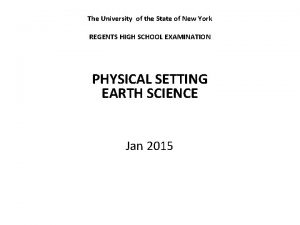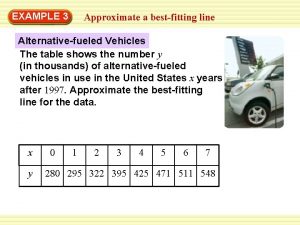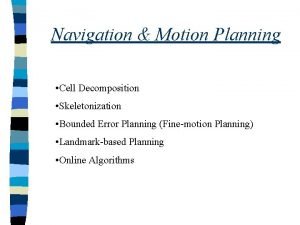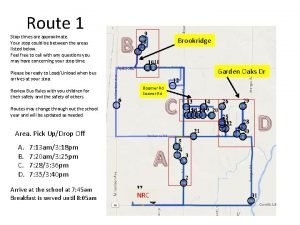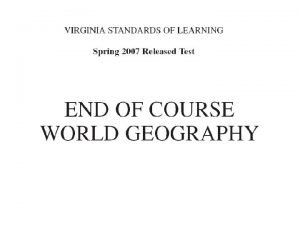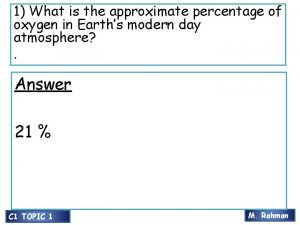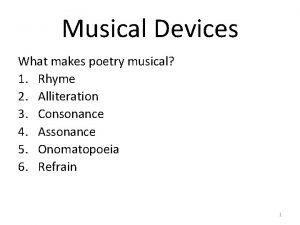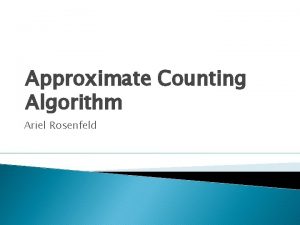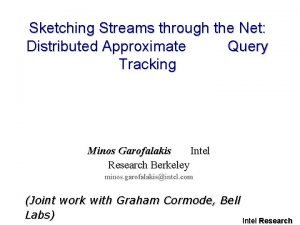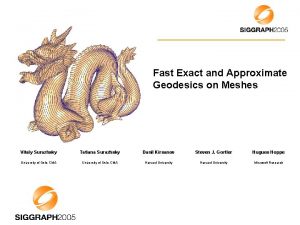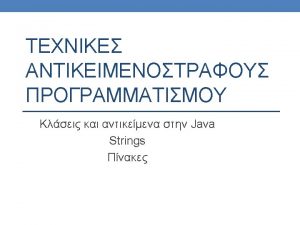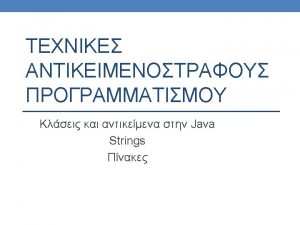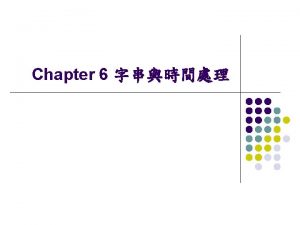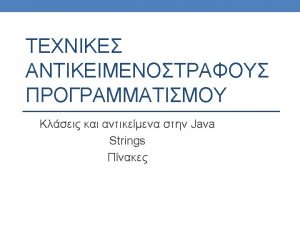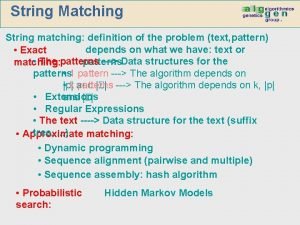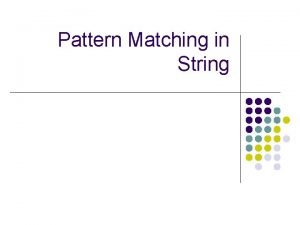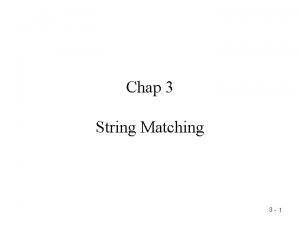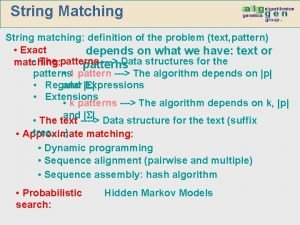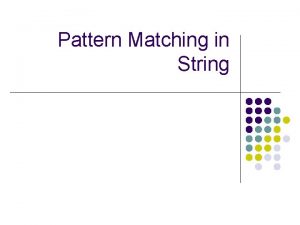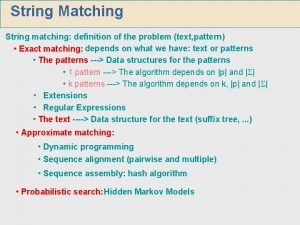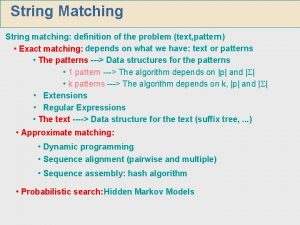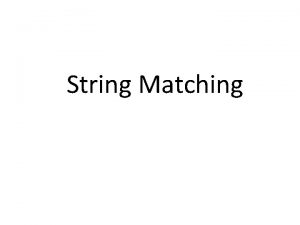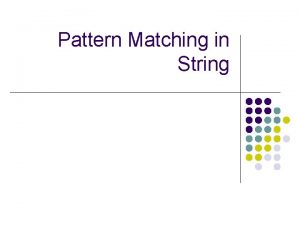Approximate String Matching A Guided Tour to Approximate
























![Improvements �In 1996 Kurtz[1996] proposes lazy construction of DFA �Space requirements reduced to O(mn) Improvements �In 1996 Kurtz[1996] proposes lazy construction of DFA �Space requirements reduced to O(mn)](https://slidetodoc.com/presentation_image/2a0ab1c8896469bb7755295647930d59/image-25.jpg)














- Slides: 39

Approximate String Matching A Guided Tour to Approximate String Matching Gonzalo Navarro Justin Wiseman 1

Outline: �Definition of approximate string matching (ASM) �Applications of ASM �Algorithms �Conclusion 2

Approximate string matching �Approximate string matching is the process of matching strings while allowing for errors. 3

The edit distance �Strings are compared based on how close they are �This closeness is called the edit distance �The edit distance is summed up based on the number of operations required to transform one string into another 4

Levenshtein / edit distance �Named after Vladimir Levenshtein who created his Levenshtein distance algorithm in 1965 �Accounts for three basic operations: �Inserts , deletions, and replacements �In the simplified version, all operations have a cost of 1 �Example: “mash” and “march” have edit distance of 2 5

Other distance algorithms �Hamming distance: �Allows only substitutions with a cost of one each �Episode distance: �Allows only insertions with a cost of one each �Longest Common Subsequence distance: �Allows only insertions and deletions costing one each 6

Outline: �What is approximate string matching (ASM)? �What are the applications of ASM? �Algorithms �Conclusion 7

Applications �Computational biology �Signal processing �Information retrieval 8

Computational biology �DNA is composed of Adenine, Cytosine, Guanine, and Thymine (A, C, G, T) �One can think of the set {A, C, G, T} as the alphabet for DNA sequences �Used to find specific, or similar DNA sequences �Knowing how different two sequences are can give insight to the evolutionary process. 9

Signal processing �Used heavily in speech recognition software �Error correction for receiving signals �Multimedia and song recognition 10

Information Retrieval �Spell checkers �Search engines �Web searches (Google) �Personal files (agrep for unix) �Searching texts with errors such as digitized books �Handwriting recognition 11

Outline: �What is approximate string matching (ASM)? �What are the applications of ASM? �Algorithms �Conclusion 12

Algorithms �Definitions �Dynamic Programming algorithms �Automatons �Bit-parallelism �Filters 13

Definitions �Let ∑ be a finite alphabet of size |∑| = σ �Let T є ∑* be a text of length n = |T| �Let P є ∑* be a pattern of length m = |P| �Let k є R be the maximum error allowed �Let d : ∑* × ∑* R be a distance function �Therefore, given T, P, k, and d(. ), return the set of all text positions j such that there exists i such that d(P, Ti. . j) ≤ k 14

Algorithms �Definitions �Dynamic Programming algorithms �Automatons �Bit-parallelism �Filters 15

Dynamic Programming �oldest to solve the problem of approximate string matching �Not very efficient �Runtime of O(|x||y|) �However, space is O(min(|x||y|)) �Most flexible when adapting to different distance functions 16

Computing the edit distance �To compute the edit distance: ed(x, y) �Create a matrix C 0. . |x|, 0. . |y| where Ci, j represents the minimum operations needed to match x 1. . i to y 1. . j �Ci, 0 = i �C 0, j = j �Ci, j = if(xi = yj) then Ci-1, j-1 else 1 + min(Ci-1, Ci, j-1, Ci-1, j-1) 17

Edit distance example �Ci, 0 = i �C 0, j = j �if(xi = yj) Ci, j = Ci-1, j-1 else Ci, j = 1 +min(Ci-1, Ci, j-1, Ci-1, j-1) 18

Text searching �The previous algorithm can be converted to search a text for a given pattern with few changes �Let y = Pattern, and x = Text �Set C 0, j = 0 so that any text position is the start of a match �Ci, j = if(Pi = Tj) then Ci-1, j-1 else 1+min(Ci-1, j, Ci, j-1, Ci-1, j-1) 19

Text search example �In English: if the letters at the index are the same, then the current position = the top left position. If the letters are not the same, then the current position is the minimum of left, top, and top left plus one. 20

Improvements �Example algorithm listed was the first �Many DP based algorithms improved on the search time �In 1992, Chang and Lampe produce new algorithm called “column partitioning” with an average search time of O(kn÷√σ) where k=errors, n=text length, and σ=size of alphabet 21

Algorithms �Definitions �Dynamic Programming algorithms �Automatons �Bit-parallelism �Filters 22

Automatons for approx. search �Model search with a nondeterministic finite automata � 1985: Esko Ukkonen proposes a deterministic form �Fast: deterministic form has O(n) worst case search time �Large: space complexity of DFA grows exponentially with respect to the pattern length 23

NFA example with k = 2 Matching the pattern “survey” on text “surgery” 24
![Improvements In 1996 Kurtz1996 proposes lazy construction of DFA Space requirements reduced to Omn Improvements �In 1996 Kurtz[1996] proposes lazy construction of DFA �Space requirements reduced to O(mn)](https://slidetodoc.com/presentation_image/2a0ab1c8896469bb7755295647930d59/image-25.jpg)
Improvements �In 1996 Kurtz[1996] proposes lazy construction of DFA �Space requirements reduced to O(mn) 25

Algorithms �Definitions �Dynamic Programming algorithms �Automatons �Bit-parallelism �Filters 26

Bit-parallelism �Takes advantage of the inherent parallelism of computer when dealing in bits �Changes an existing algorithm to operate at the bit level �Operations can be reduced by factor of w where w is the number of bits in a word 27

Shift-Or �Was the first bit-parallel algorithm �Parallelizes the operation of an NFA that tries to match the pattern exactly �NFA has m+1 states 28

�Builds table B which stores a bit mask for every character c �For the mask B[c], the bit bi is set if and only if Pi = c �Search state is kept in a machine word D = dm. . d 1 �di is 1 when P 1. . i matches the end of the text scanned so far �Match is registered when dm = 1 29

�To start, D is set to 1 m �D is updated upon reading a new text character using the following formula �D’ ((D << 1) | 0 m-1 1) & B[Tj] �This representation ends up working similar to a DFA in that the final state is only reached if the previous state has been reached and so on. 30

Algorithms �Definitions �Dynamic Programming algorithms �Automatons �Bit-parallelism �Filters 31

Filters �Originating in the 1990’s �Filter algorithms attempt to filter out large sections of code based on the fact that a given pattern can not be there �Needs a different kind of algorithm to check portions of text which are not filtered out 32

conceptually �Filter algorithms are really exact match pattern searchers �Exact pattern matching is much quicker �Breaks up original pattern into parts and searches the text for those exact parts �Example from Navarro: if “sur” and “vey” don’t appear in a section, then “survey” can’t either 33

Filters �must be paired with a non-filter algorithm such as one of the dynamic programming algorithms �Performance dependant upon number of errors allowed �Are the fastest of the algorithms surveyed �Best theoretical average cost O(n(k + logσ m)/m) 34

Hierarchical verification method �Created by Navarro and Baeza-Yates in 1998 �Original pattern is recursively split with each half searching on k/2 errors �In example: if search on text “xxxbbxxxxxx”, the leaf “bbb” will return a match with one error �Checking the parent subdivision shows that there is no match 35

Outline: �What is approximate string matching (ASM)? �What are the applications of ASM? �Algorithms �Conclusion 36

Conclusion �Generally a combination of a fast filter and a fast verifying algorithm is the fastest overall �For non-filtering algorithms, a NFA bit-parallelized by diagonals is the fastest �Approximate string matching has greatly influenced the field of computer science and will play an important role in future technology. 37

References �“A Guided Tour to Approximate String Matching”, Gonzalo Navarro �“Implementation of a Bit-parallel Aproximate String Matching Algorithm”, Mikael Onsjo and Osamu Watanabe �“A Partial Deterministic Automaton for Approximate String Matching”, Gonzalo Navarro �http: //en. wikipedia. org/wiki/Approximate_string_ma tching 38

Approximate String Matching A Guided Tour to Approximate String Matching Gonzalo Navarro Justin Wiseman 39
 A guided tour to approximate string matching
A guided tour to approximate string matching A guided tour to approximate string matching
A guided tour to approximate string matching Http protocol description
Http protocol description Tour petronas et tour eiffel
Tour petronas et tour eiffel Tour escort jobs
Tour escort jobs Dangerous world tour history world tour - hockenheimring
Dangerous world tour history world tour - hockenheimring String matching
String matching Fft string matching
Fft string matching String matching finite automata
String matching finite automata Site:slidetodoc.com
Site:slidetodoc.com Cse 333
Cse 333 Algorithm for string matching
Algorithm for string matching String matching
String matching String matching
String matching Input enhancement in string matching
Input enhancement in string matching Char char slide
Char char slide Private.com
Private.com Str string
Str string Voltage devider bias
Voltage devider bias The diagram below represents the placoderm fish
The diagram below represents the placoderm fish Approximate the best fitting line for the data
Approximate the best fitting line for the data Example of sonnet poem
Example of sonnet poem Approximate cell decomposition
Approximate cell decomposition Approximate analysis
Approximate analysis What is the approximate value of a gigabyte
What is the approximate value of a gigabyte Times are approximate
Times are approximate Art bell ringers
Art bell ringers It refers to the focal terminus of fingerprint pattern
It refers to the focal terminus of fingerprint pattern What are the approximate dates of the baroque period
What are the approximate dates of the baroque period What is the approximate
What is the approximate Approximate computing
Approximate computing Approximate computing
Approximate computing What is the approximate percentage of oxygen in the air?
What is the approximate percentage of oxygen in the air? What are musical devices
What are musical devices External rhyme examples
External rhyme examples Approximate counting algorithm
Approximate counting algorithm Https://lshzoo.cc
Https://lshzoo.cc Board ga,e
Board ga,e Sketch techniques for approximate query processing
Sketch techniques for approximate query processing Fast exact and approximate geodesics on meshes
Fast exact and approximate geodesics on meshes
